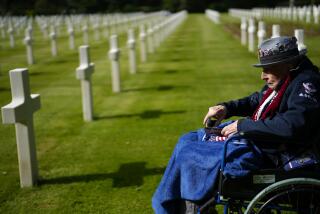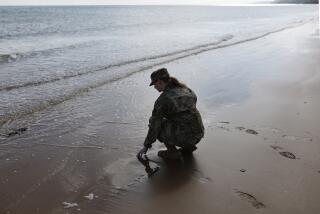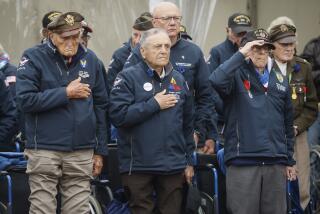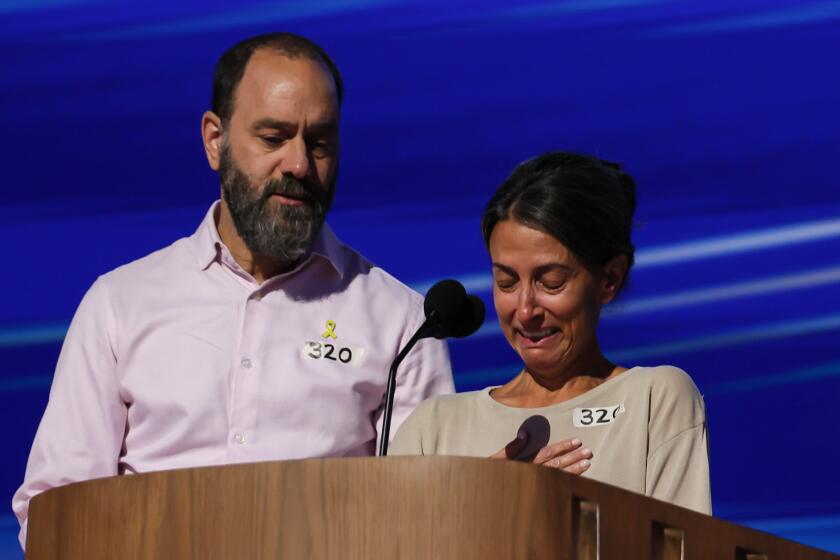Veteran Paratroopers Reunite, Remember
NEW CUMBERLAND, Pa. — As hundreds of paratroopers jumped from a hazy morning sky, Edward Whalen recalled the night he parachuted into France and landed amid startled Germans, hours before the D-Day beach assault.
“I got hooked up in a tree and a guy was shooting at me--about 3 feet over my head,” the 81-year-old veteran of the 82nd Airborne Division said. “Then he ran away. They got scared too.”
Whalen reached the ground unscathed before dawn on that June morning in 1944, just as he did in three other combat jumps in World War II--two in Italy and one in the Netherlands.
“Jumping’s for the birds. That’s why God gave them wings,” Whalen said. “I jumped because that was our mission.”
Whalen, of Metairie, La., was among a crowd of veterans and spectators who watched about 300 members of the 82nd jump from six planes that had flown from the division’s home base of Ft. Bragg, N.C.
The demonstration was part of the annual meeting of the 82nd Airborne Division Assn., a group of active and veteran paratroopers who met this month in nearby Harrisburg.
The troopers jumped from 800 feet, about twice the altitude of a combat jump. A long descent is dangerous when the enemy is on the ground.
“You jump right where you’re going to fight,” Whalen said. “The less of a target you are, the better.”
The 82nd’s hallmark is readiness. Its troops are prepared to depart without notice for fighting anywhere in the world. In addition to World War II, the unit saw action in Vietnam and the Persian Gulf War, as well as military operations in Grenada and Panama.
Bill Leonard of Lancaster, Pa., said the reunions offer veterans the chance to catch up with one another and relive experiences both fun and frightening.
“You get a couple of guys together, without their wives, and you can have a pretty good bull session,” he said. “We caught hell no matter where we were. It seemed like they always put us up in the front.”
Leonard jumped into combat three times in World War II, the last time in the Netherlands, as Allied troops attempted to capture a series of bridges that would allow infantry units and tanks to press toward Germany.
One bridge was taken by the 82nd by water, as paratroopers paddled rubber boats across the Waal River under German fire. Leonard said only two of the 12 men in his boat made it across the river without being wounded or killed.
“We got halfway across . . . the guy on the right, his head was in the water, I pulled him out,” said Leonard, who was shot in the leg.
Years later, Leonard returned to the town of Nijmegen and crossed the bridge in a tour bus. As he looked down to the river, he was struck by the calm and ordinary nature of the scene.
“You just wonder, was it worth all that?” he said.
Richard Mote, 73, of Indianapolis, attended the Aug. 13 jump in a military campaign cap, decorated with patches and pins, some from the D-Day 50th anniversary ceremonies at Normandy.
The French people, he said, remained grateful half a century later for the sacrifices of American troops in driving out the Nazis.
“The people, they didn’t forget,” Mote said. “They’d say, ‘American paratroopers. You freed us from five years of slavery.’ ”
Mote, a retired history teacher, said he felt it was important to share his wartime experiences with his students.
“When we got to World War II, I say to the kids, ‘Put the book away. I was there,’ ” he said. “This is not an ego thing. It was horrifying. . . . I don’t want them to forget it. I don’t want my grandchildren to forget it.”
More to Read
Sign up for Essential California
The most important California stories and recommendations in your inbox every morning.
You may occasionally receive promotional content from the Los Angeles Times.










